
ASIA HUNDREDS is a series of interviews and conference presentations by professionals with whom the Japan Foundation Asia Center works through its many cultural projects.
By sharing the words of key figures in the arts and cultures in both English and Japanese and archiving the "present" moments of Asia, we hope to further generate cultural exchange within and among the regions.
Theater to Promote Civic Engagement
Fujioka Asako (hereinafter Fujioka): Both of you are affiliated with Thukhuma Khayeethe Theatre and the Gitameit Music Center. Can you describe these institutions?
Thila Min (hereinafter Thila): I co-founded Thukhuma Khayeethe Theatre in 2009. It is mainly focused on theater and performance arts, and is really a theater to promote civic engagement and community participation.
Gitameit Music Center is a community music organization. I work for their community outreach program. We started to give art classes to underprivileged children, especially in monastery schools. It was before 2010 when we began.
In our country, the role of the monastery school is really important because of poverty. A lot of migrant workers who move near Yangon bring their children. These children cannot go to the government school because they cannot afford it. So around that area, the monasteries started a school system that teaches the government curriculum. But they don't have arts classes, so the Gitameit Music Center organized a program where we teach visual arts, music, and drama. I am the manager of the program and also the trainer and teacher of drama.
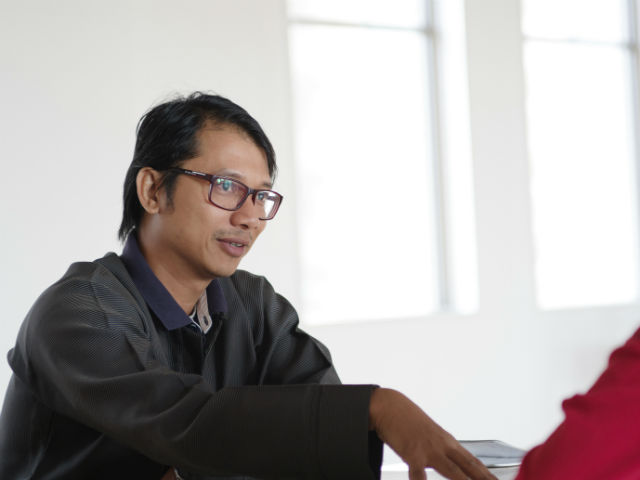
Fujioka: Soe Moe, do you also participate in these training initiatives?
Soe Moe Thu (hereinafter Soe Moe): Yes. My first time was the theater class in 2008 after Cyclone Nargis.*1 After the devastation, I saw an online announcement for volunteer social work by the Gitameit Music Center. I'm interested in music and so I wanted to help them. At first, I was in drama training and now I also work on teaching and performing.
*1 Cyclone Nargis was the worst natural disaster in the country's history. It hit Myanmar on May 3, 2008, devastating the land and leaving over 130,000 dead or missing.
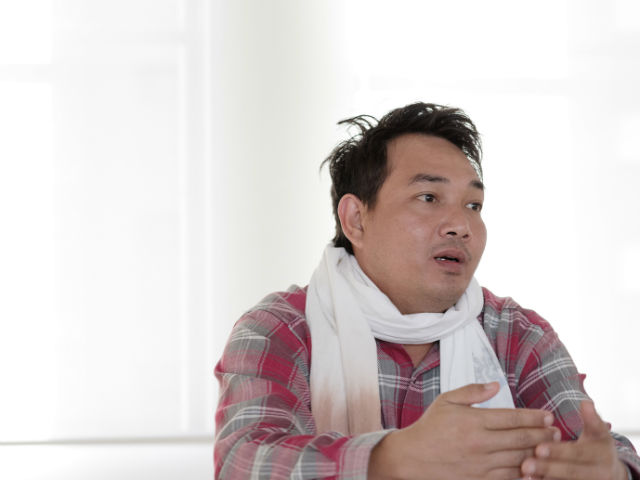
Fujioka: What about your own theater work?
Thila: To answer that question, I would like to start with a little background on Myanmar. As you know, I'm a former political prisoner and I really wanted to participate in the community development of my country and also in the arts, because I was very fond of the field. Then I started thinking that theater is not a one-man job; theater production needs people, it means working together towards one goal, one successful performance. And, because I really wanted to work with people, I started organizing activities with young people.
When I create my own production, I always start by thinking about the social issues of our target audience and what kind of issues they are facing right now in the present.
After that, I start thinking and talking with my actors: I ask questions about their experience on an issue, to think about it. After that, we try to improvise around it. Through this process, we begin to see some scenes, some storylines. We rehearse and mainly go to communities and perform there. Most of our performances are in the communities.
Fujioka: It's very participatory and collaborative.
Thila: True. As a director and artistic director, I don't want to force my own story on the actors. I really want them to participate in creating the story. That's my idea. In Myanmar, we had almost sixty years of military regime. So all our minds are stuck; we don't think much. Most of my actors are young people who are interested in arts and I really want them to think.
Fujioka: Theater is like a workshop to open their minds.
Thila: Yes, kind of like that. I also introduce social issues. They start thinking about this issue and relate to it from their own experiences, which they then act out. That's the way I create, and how I get inspiration from them.
Myanmar Through Metaphors
Fujioka: Can you give an example of the process?
Thila: Last year, we held a two-week workshop inviting young people from different parts of Myanmar. In that workshop, the theme was "Rule of the Law." For example, one group was from Kachin State*2 where they have a lot of drug issues. The young people are facing this kind of challenge. They raised this topic, started discussing it, and created the story.
They came up with the character of a bean seller which is a metaphor for a drug dealer. The beans are a metaphor for methamphetamine tablets. The bean seller sells his produce, the king allows the citizens to eat the beans. The sellers keep selling them and everyone keeps eating them believing the sellers' marketing strategy that say, "Ok, the beans are really good. If you eat them, they will give you lots of good energy." But then, the king starts saying, "No, you cannot sell the beans anymore. Those eating the beans are getting stomach aches." They start arresting the bean sellers and also those who have purchased or consumed them. It is connected to the Rule of the Law. But then the bean sellers start to bribe the police. That's corruption. This is the main issue in the Rule of the Law in Myanmar.
*2 Kachin state is located at the northernmost state of Myanmar, bordered by China to the north and east and India to the west.
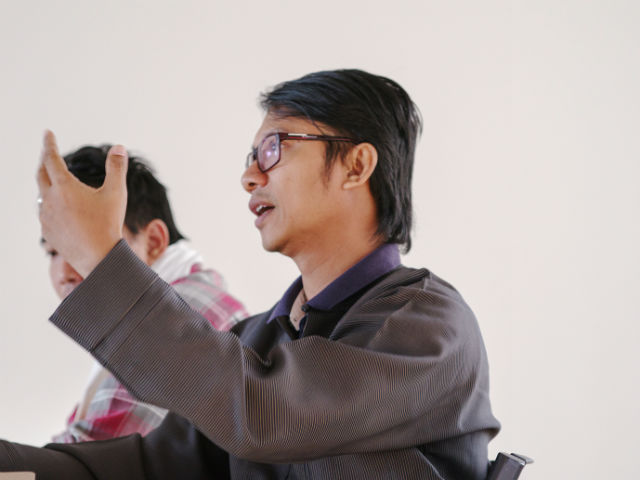
Fujioka: It tells a story of Myanmar's reality through metaphors.
Thila: The seller bribes the police to avoid being arrested, and the consumers are now addicted so they can't stop eating them. They go out to buy them, eat them, and then the police arrest them. But the addict doesn't have money to bribe the police. Only the seller does. So when the addict is arrested and being abused by the police, we stop the play and ask the audience, "Do you like this? What do you think? Why was he arrested?" The audience reply, "Oh, he cannot pay," "Why wasn't the seller arrested?" To which we again ask, "Ok, if you don't like this kind of ending, what solution can we create?" So we end up asking the audience, and this becomes the play.
Fujioka: I see. You're playing the role of a facilitator.
Thila: The actors bring in their ideas, their experiences, and I devise the piece. We use metaphors because if we tell the story directly, there might be a risk for the artists: when we go into the communities, we don't know who is actually a drug dealer or user, or even who's the police. That's why we use metaphors so we can say we are not talking about anyone in particular; to show that this is an imaginary story in an imaginary country.
Fujioka: So at the end of the two-week training, do you perform this in Yangon or do you travel to different communities?
Thila: For this piece, we did one in Yangon and at least four in Kachin State: we took it back to the actors' communities and they performed it there. All the performers for this piece were from Kachin State. They are not trained actors, but young people interested in the arts. The first two weeks was a kind of capacity-building period for their acting skills and also a chance to experience developing their stories.
Fujioka: Soe Moe, were you also a part of this group?
Soe Moe: Yes, for the teaching and facilitating, and some parts of the coordination with the trainers and participants. As a coordinator I work with the local community organizers so that we can perform there. Like a production manager.
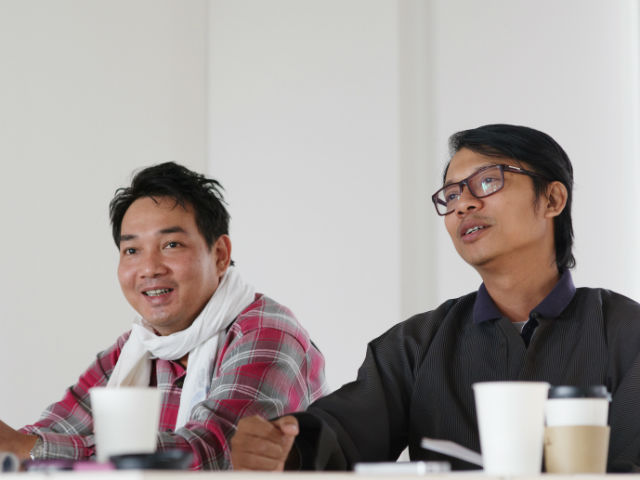
Fujioka: What kind of background do the workshop participants have?
Soe Moe: Some are university students and some are community volunteers in social welfare. Their ages are between eighteen and thirty. Some people are older but they're really, really interested in television and drama, so they join us.
Fujioka: I imagine as a team work, it's more interesting to have diverse people to work together.
Thila: Myanmar is now undergoing a peace process. I believe national reconciliation starts at the grassroots, that's why I try to work with all ethnicities in Myanmar. In the past two years of this program, we have invited people from almost all states and divisions. It's rebuilding our youth.
For fourteen days, we have a camp where we stay in an isolated area in a forest near Yangon, for example. One of the activities we have is called "Personal Mapping." I make each of them think about three past experiences, happy or sad, and I ask them to draw a picture of each experience, which they will then share with the rest of the group. They get to know and interact with each other through this exercise. It helps them understand each other; people from different parts of Myanmar, different ethnicities. This really makes our work easier because after that, they have to create stories together and act it out. It's a really effective way to build trust among a diverse range of people.
Soe Moe: That's how the network stays and continues. Someone from one part of Myanmar has a theme for a performance, and they can help me invite people from other states. The network becomes stronger that way.
Thila: In Myanmar right now, we cannot afford to do art 100 percent. As an artist, whenever I create, my inspiration has to start from my community and its social issues.
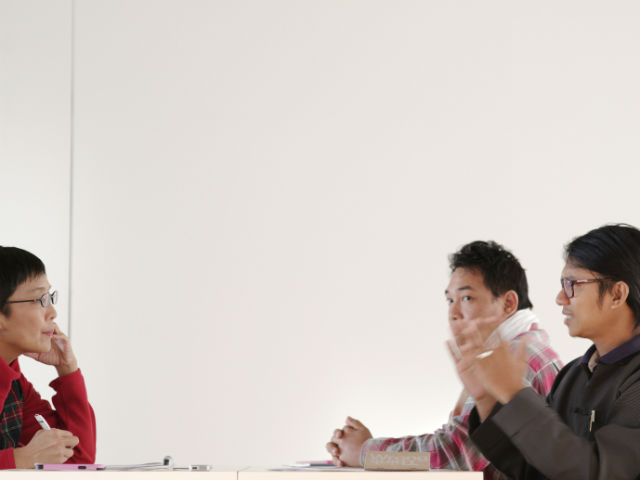
After the Political Change
Fujioka: What are you experiencing now after 2015?
Thila: Yes, freedom of expression is a little stronger today; everybody can have their voice, even Buddhist extremists for example. I have to mention this: even extremists with extreme ideologies have the right to express themselves. But sometimes it is not good for the community, for the country, because they incite violence and hatred. That's not good.
When we start our programs, we don't know who will be taking part. Is it government officials? When they were wearing their uniforms, we used to see who was who clearly, but now we don't know who is an extremist, who is for or against the issue that we are addressing. So that's why I have to think very carefully. Whenever I address an issue in a play, we use metaphors and humor.
Fujioka: I noticed that you even work with Broadway musicals and European clown theater. Your career has covered a wide range of performing arts.
Thila: In Myanmar, we only have one university for the arts. There, they focus only on the traditional arts: dance, music, and a little bit of acting in the cinematography major. So when I started theater, the only chance I had was to learn from international artists. I really wanted to do theater; to direct and act in theater. So every time international artists had workshops organized by a foreign embassy or cultural center, I participated. Whenever clowns came and did a workshop, I went. In that way, I participated in all kinds of workshops; on musicals, clown theater, and acting.
With the Bond Street Theatre,*3 we worked on a collaboration. I learned from them. I am now able to participate in international workshops outside of Myanmar, and I am still learning. Also, we do Forum Theatre initiated by the Brazilian director Augusto Boal. He called it the "Theatre of the Oppressed." I eagerly followed this because I really think this is what our country needs right now. I want the people to start thinking about themselves and start doing something by themselves. The stars are the people from the community. They start creating their own stories. They perform in their communities and find solutions to the social issues they face.
*3 Founded in 1976 in New York City, Bond Street Theatre is committed to furthering peace and cross-cultural understanding through creative associations with artists worldwide, creating theater-based projects for education, healing, and empowerment in critical areas, and training instructors in these techniques to insure the sustainability of its artistic-humanitarian programs.
Fujioka: People of the community performing for the community?

Thila: Yes. For example, domestic violence is a big issue in one village. They come together and maybe a director or somebody from the outside facilitates the performance. They create a short story of maybe fifteen minutes, with an ending that is "bad." When we perform this in front of the audience, the actors stop and ask the audience, "Do you like this ending?" If they don't say "yes," we act out the story again. We tell them, "If you see a way to change this ending, say 'stop.'" Sometimes, the audience can come [on stage] and replace a character in the story. And once on stage, he or she can try to change the storyline to make a better ending.
Boal said this is a "rehearsal for life." In our lives, we don't have any rehearsal time; but in a play, you can rehearse. This solution may or may not work. It doesn't matter. One audience can say, "Ok, that's one way." But another might think, "Oh no, it won't work, stop. I'll do it another way." In this way, they are finding solutions by discussing. This is Forum Theatre.
Fujioka: How many performing arts groups like yours exist in Myanmar now?
Thila: In traditional theater, there are many. But in contemporary theater, we are one of only two or three groups. This year, we are trying to introduce and promote contemporary theater to the local communities and areas.
Fujioka: A lot of performing arts in Asia is attached to tourism but your work is not. How do you manage things financially?
Thila: We try to find funding through donations and call for collaborators. In the future, we really want to make a contemporary theater venue. There's no proper theater in Yangon; there's a national theater but it is very old and also very expensive to use. This is our challenge.

- Next Page
- Why Theater?






